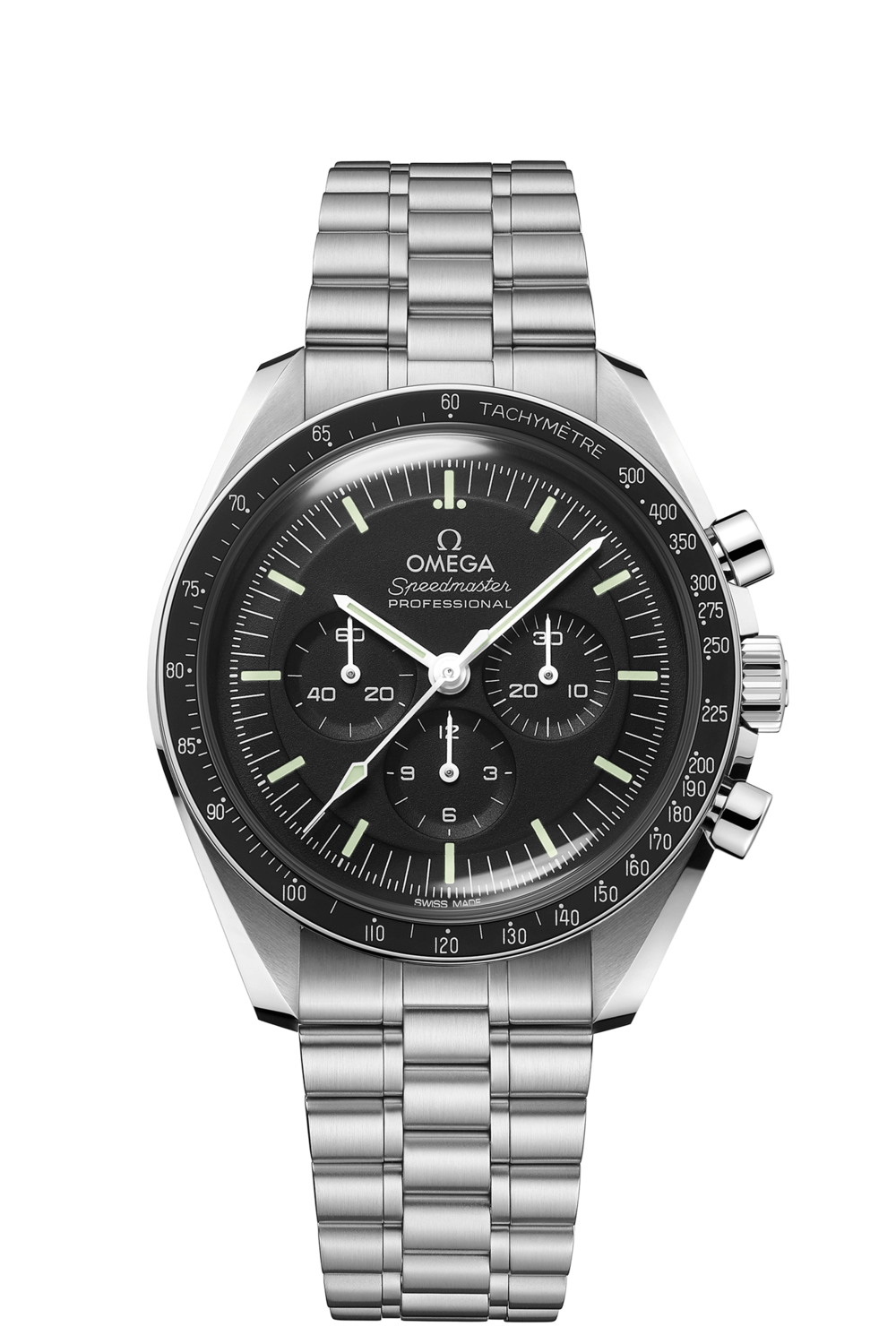Understanding vintage Omega Speedmaster watches
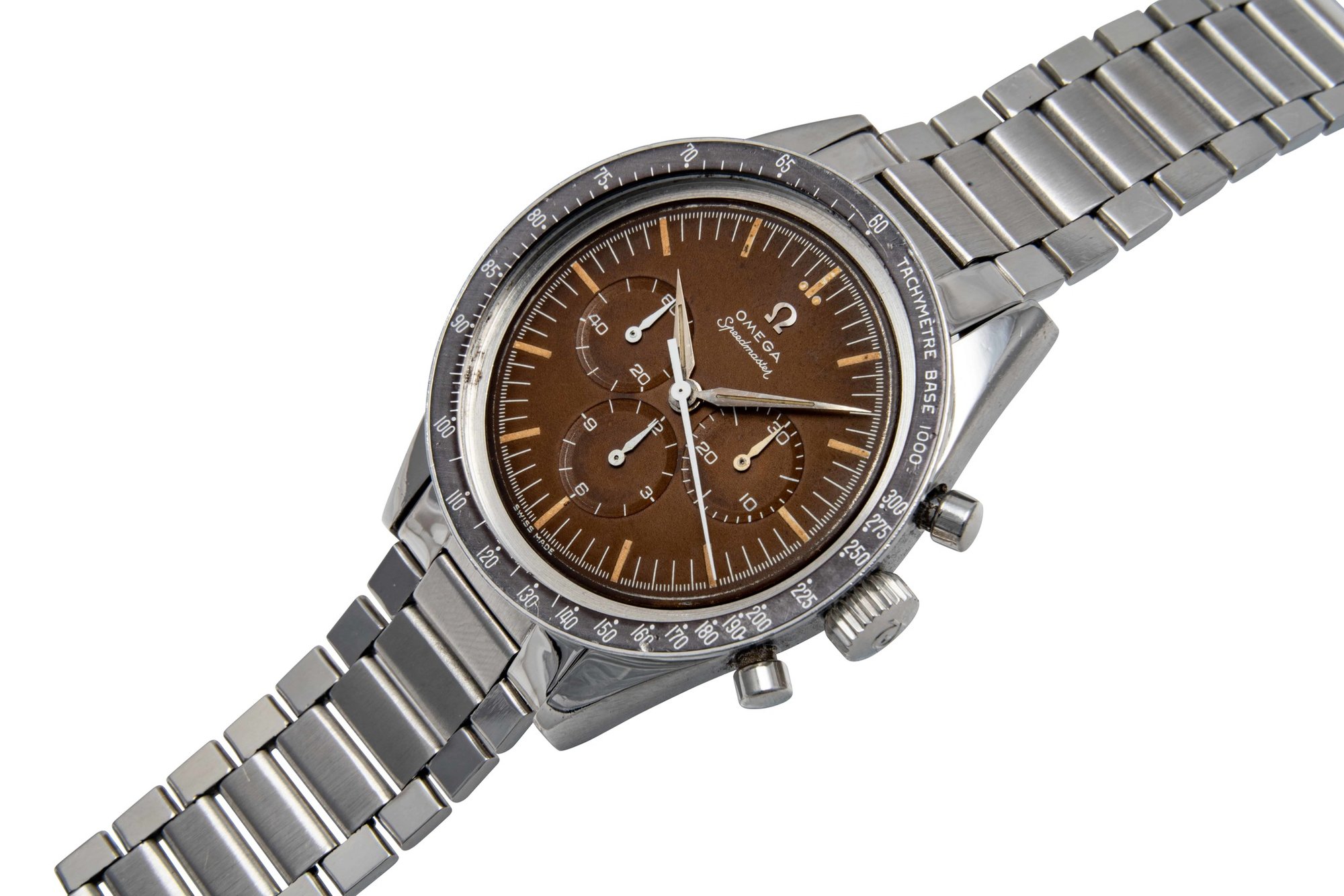
Published: Jul 23, 2021
The Omega Speedmaster, also known as the “Speedy” is one of the most famous chronographs in the entire world. From planet earth to outer space, the Speedmaster collection, which includes everything from the classic Moonwatch to high-end Speedmaster special editions, is home to various models including quartz-powered, manual chronographs, automatics fitted with Co-Axial movements and various analogue and digital displays.
In this guide to understanding the iconic Omega Speedmaster, we’ve outlined all the most important vintage Speedmaster models from the past, right up to some of the newer additions developed during the 1990s. We’ve also included some advice regarding the price of various vintage Speedmaster watches and what to expect should you be looking to start your own vintage Speedmaster watch collection today.
The historical background of the Omega Speedmaster
For many enthusiasts, the Omega Speedmaster has always been associated with the Moonwatch, yet the first model was released back in 1957 and was part of the “Professional” collection. Its family members were the likes of the Railmaster and Seamaster 300. Its core design was, in fact, intended for the racetrack. The sporty watch with 1/5th of a second chronograph was introduced to compliment Omega’s role as the Official Timekeeper for the Olympics and didn’t attract the attention it deserved from the aeronautics industry until 1962. The first Omega Speedmaster to reach space was the ref: CK2998, worn on the wrist of one of America’s very first astronauts in the Mercury 8 mission flight on October 3rd. It had sparked an interest with the world’s globally leading civil space programme, who began acknowledging the need for a reliable and precise timekeeping instrument to assist with daring space missions.
Winning trials against other watchemakers
NASA rolled out several trials with the likes of Longines, Hamilton and Rolex, as well as Omega. A list of specifications was sent out to each watchmaker and each brand’s proposal was then subject to a line of stringent tests. The Omega Speedmaster survived these intense procedures, which included subjecting the prototype watch to adverse drops and rises in temperature, impact, pressure, water, vibration, acoustic noise, humidity, acceleration, decompression and shock. It became authenticated for space exploration and flight-certified. To this day it remains a piece of equipment used by NASA’s astronauts.
The first Omega Speedmaster – the CK2915
The Speedmaster ref: CK2915 is where the story of the icon really begins. The incredibly rare timepiece is considered by serious Speedy aficionados as the holy grail to any Speedmaster collection. Developed in 1957, it can now sell for over 40K euros because of its desirability and rarity. Alongside the Speedy CK2915, Omega launched the Seamaster 300 ref: CK2913 and the Railmaster ref: CK2914. One of the most notable characteristics of this very first Speedy was the implementation of the world’s first-ever bezel-mounted tachymeter scale to feature outside the crystal. Before then tachymeter scales had always featured on the dial itself. The Speedmaster CK2915 was known as the “broad arrow” model because of its arrow-tipped hour hand – a feature shared at the time with Omega Seamaster watches and Omega Railmaster watches. The metallic tachymeter bezel featured engraved numbers, framing a black oxidised stepped dial that features a recessed edging along with three registers – each one recessed with a circular guilloche finish. The luminous hour markers and hands were filled with radium. Two stand-out features of the Speedmaster ref: CK2915 that differed from later editions were its metallic engraved tachymeter bezel and a simple baton second hand.
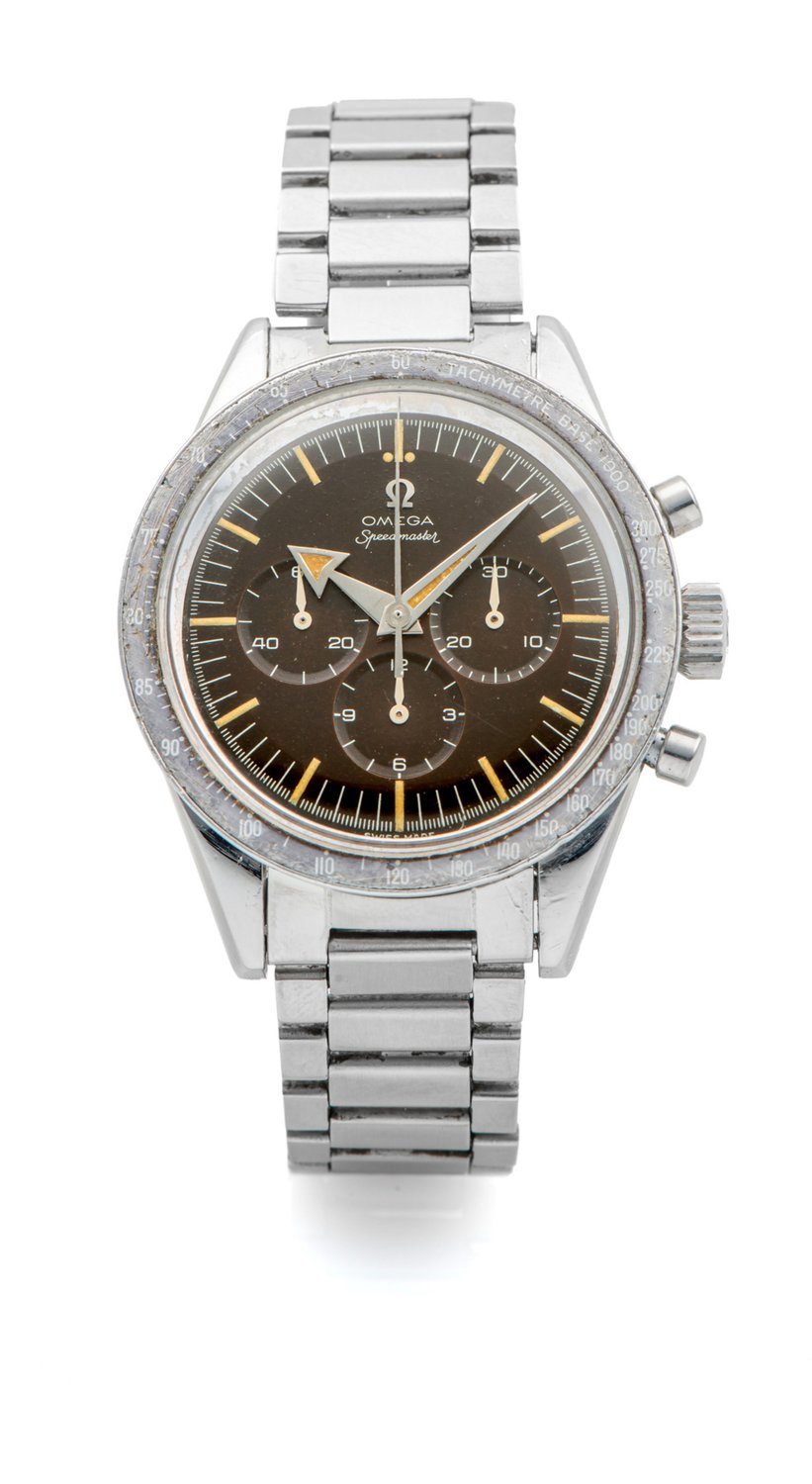
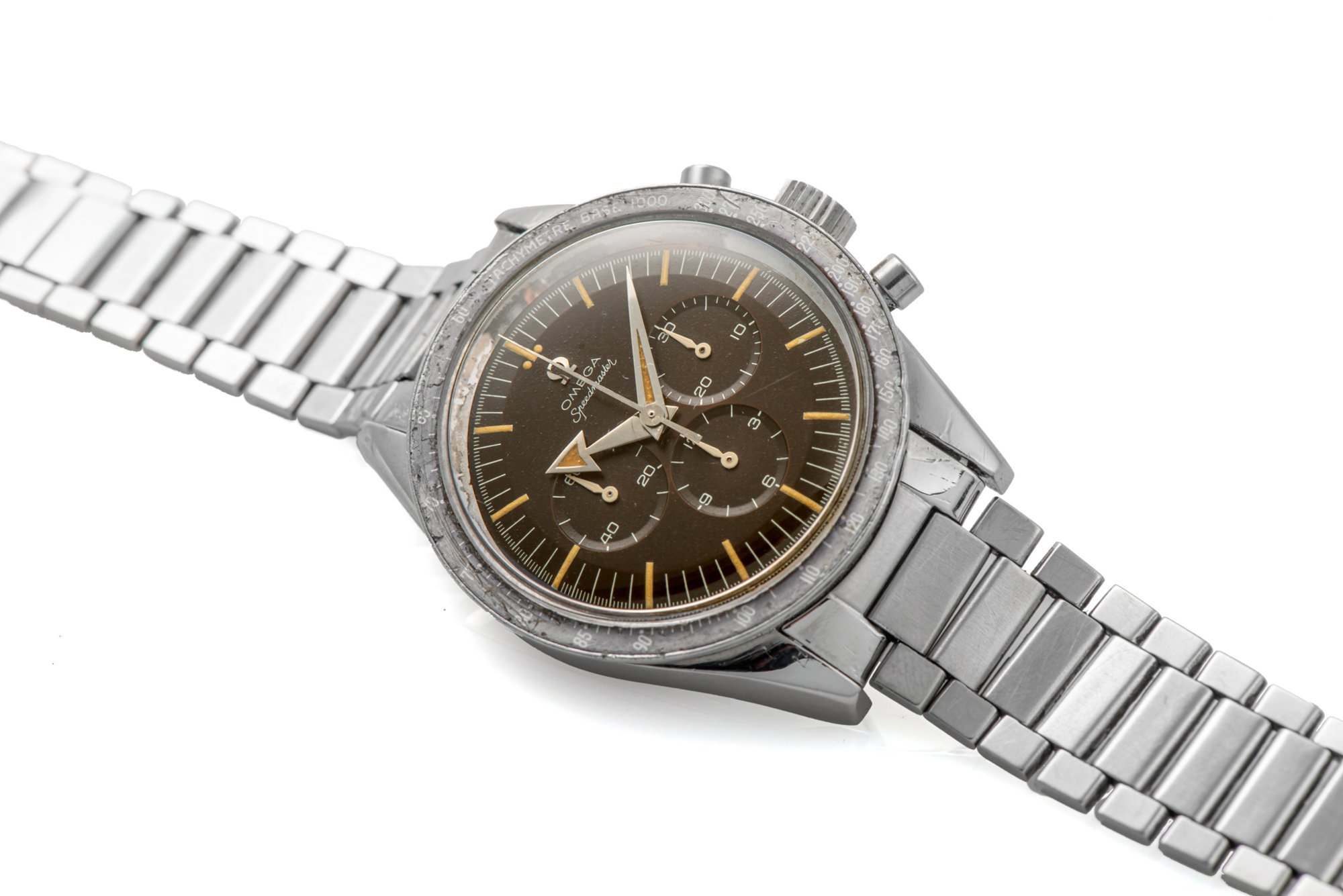
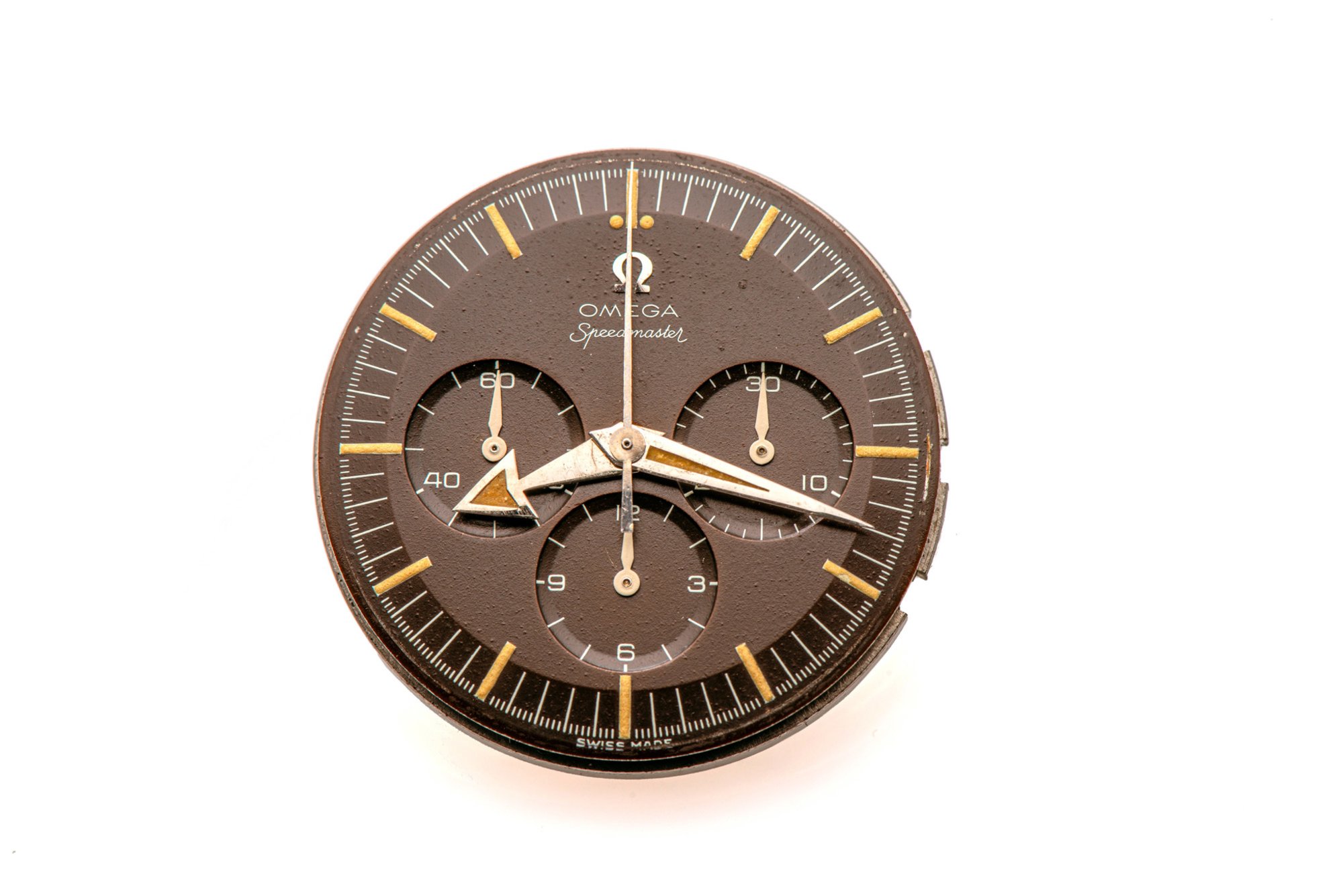
The stainless steel watch measured 38.6mm and held the Calibre 321 at its centre – a collaborative effort between Omega and Lemania. Equipped with anti-magnetic and shock-protection capabilities along with a lateral clutch and column wheel – the Calibre 321 was, for its time, a cutting-edge movement for serving the needs of NASA astronauts. The Speedmaster CK2915 was only in production for two years before it was replaced by the CK2998.
At a glance:
Name; Omega Speedmaster “broad arrow” CK2915
Reference; CK2915
Case: 38.6mm stainless steel – straight lugs
Bezel: Metallic tachymeter bezel/engraved numbers
Glass: Domed hesalite
Release year: 1957
Dial: Black oxidised stepped dial/recessed sub-dials with circular guilloche finish/radium-filled hands and baton indexes/arrow-tipped hour hand/simple baton second hand
Strap: Stainless steel
Movement: Calibre 321
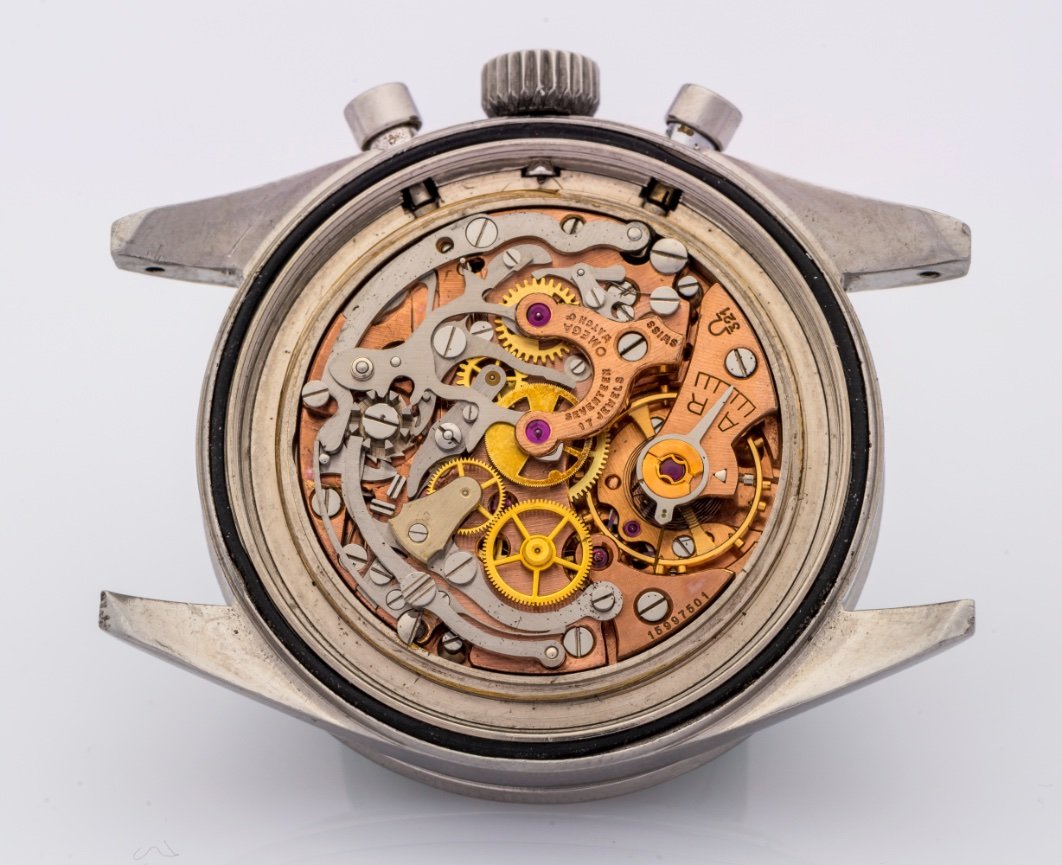
The Speedmaster Omega CK2998
In 1959 Omega released the second step of the Speedmaster’s history with the model ref: CK2998, which went on to be worn on the wrist of Wally Schirra. Most importantly of all, this was the first Speedmaster to go to space. The Speedy CK2998 marked a pivotal point in Omega’s long and rich watchmaking heritage. The famous watch has since been redesigned in the form of the 2012 Omega Speedmaster FOIS (First Omega in Space watch). The original model, however, features some subtle changes compared to the CK2915. It was equipped with the same case, dial and hands but with a new tachymeter bezel. This time, the bezel had a black aluminium insert for improvising readability in dark conditions, as well as a set of “Alpha” style hands which became one of the most distinguishable features of the CK2998 model. A radium-filled circular motif at the end of the second hand became the recognisable lollipop hand featured in some CK2998 models – a design element, once again, intended to leverage readability in conditions with poor visibility. Omega also increased the size of the watch case from the previous almost 39mm diameter to 40mm. Finally, the push-pieces located at 2 and 4 o’clock on the Speedmaster watch’s robust stainless steel case were fitted with O-ring gaskets to help the watch uphold a water-resistant environment for the Calibre 321 to perform within. Compared to the CK2915, the Omega Speedmaster ref: CK2998 is a little easier to find on the pre-owned market and comes with a lower price tag too.
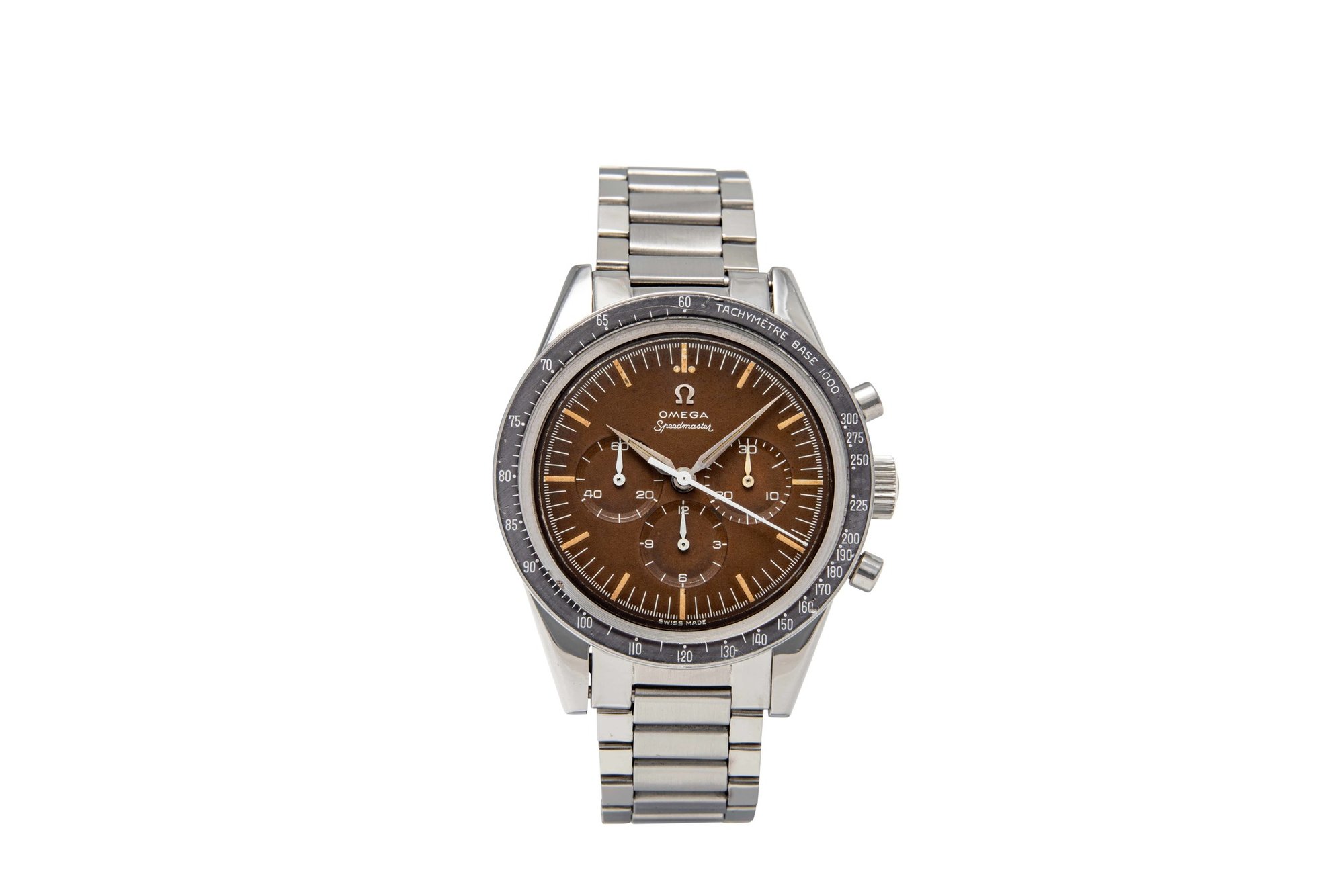
Omega watch collectors desire this second addition to the famous Speedy line, mainly because of its interesting back story and the historical landmark it represents within the aeronautics industry. The straight lugs on the watch case and “Alpha hands” impart a stylish vintage look combined with more contemporary elements like the black aluminium bezel.
At a glance:
Name; Omega Speedmaster CK2998
Reference; CK2998
Case: 40mm stainless steel -straight lugs
Bezel: Black aluminium insert tachymeter bezel
Glass: Domed hesalite
Release year: 1959
Dial: Black oxidised stepped dial/recessed sub-dials with circular guilloche finish/radium-filled “Alpha hands” and baton indexes/simple baton or lollipop second hand
Strap: Stainless steel
Movement: Calibre 321

The Omega Speedmaster 105.002 AND 105.003
Although both similar in design to the previous two models, when Omega launched the Speedmaster ref: 105.002 and 105.003, there was one subtle but key difference – the size of their bezels. The first reference was reduced back down in size, measuring 38.6mm, but between this iteration and the ref: 105.003, the bezel of the latter had enlarged to measure 39.7mm. Aside from this, the design of the Speedmaster watch’s case remains essentially the same. These two models did, however, feature some other changes to the dial. The first difference is the design of the hands, which transitioned from the “Alpha” style hands to the baton-style hands that we now see in modern-day versions of the Speedmaster watch. They were also made more prominent for use in dark conditions and were filled with tritium material. The hands of the chronograph sub-dials were executed in white to assist with legibility, while the central chronograph seconds hand is detectable via a spear-shaped or diamond-shaped tip and a teardrop-shaped counterweight.
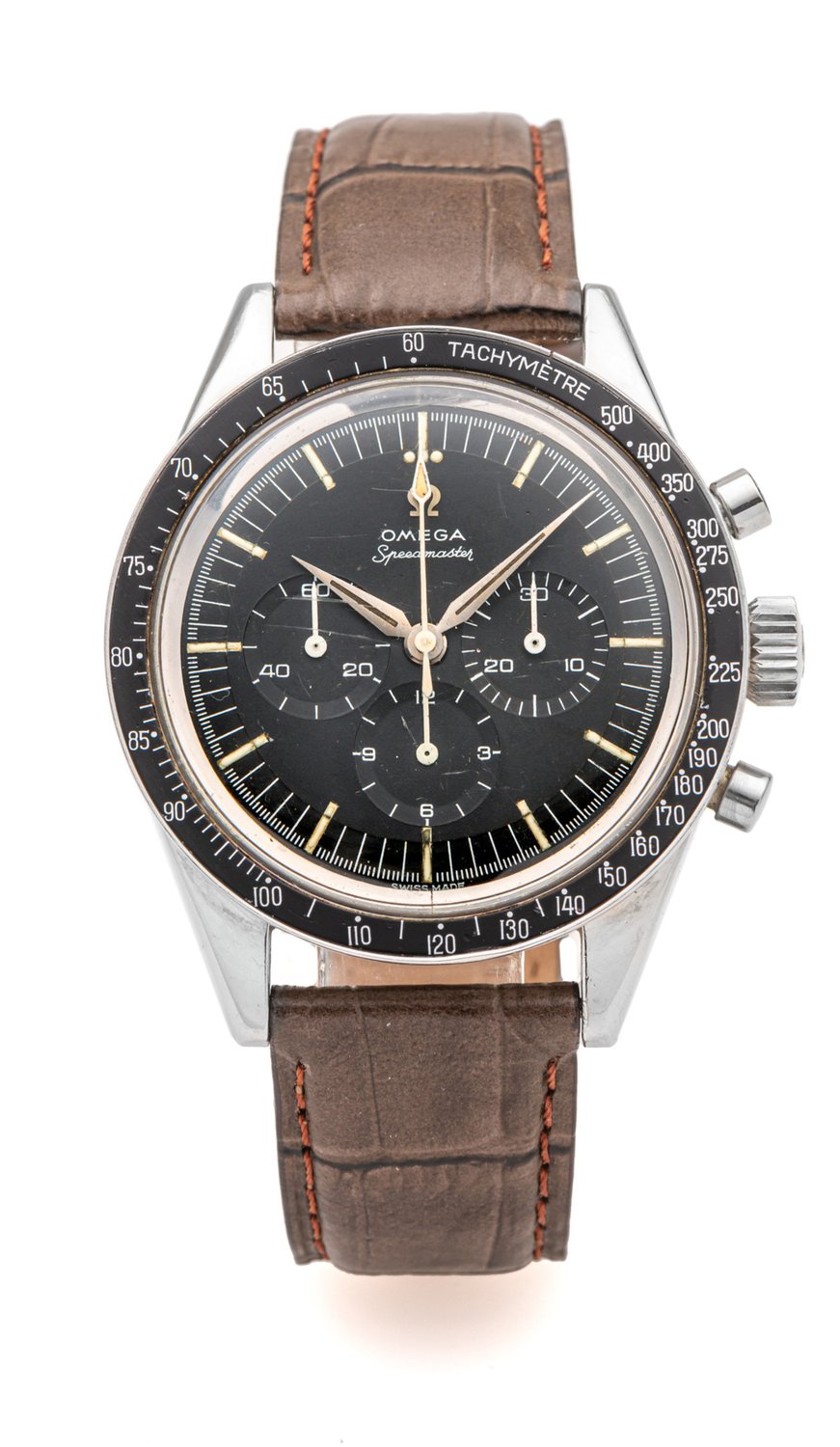
The top part of the diamond is filled with tritium, enabling it to glow in dark conditions. Where previous Speedmaster watches had featured a 12-hour sub-counter at 6 o’clock, the 105.002 and 105.003 models replaced this function with the 1/10th of a second feature, but still kept hold of the 30-minute sub-counter at 3 o’clock and the small seconds sub-dial at 9 o’clock. For the first time, the black aluminium bezel was now available with different scales. A telemile scale could calculate distances in miles, a telemeter – in meters, a pulsometer could measure heartbeats per minute and, of course, the tachymeter for measuring speed based on time. The Omega Speedmaster 105.003, released just a year after the 105.002 version, was selected by NASA as an official piece of equipment for its astronauts, but was later discontinued and instead, replaced by the 145.003.
At a glance:
Name; Omega Speedmaster 105.002 and 105.003
Reference; 105.002 and 105.003
Case: 38.6mm and 39.7mm respectively - stainless steel – straight lugs
Bezel: Black aluminium insert bezel - tachymeter/telemeter/telemile/pulsometer versions
Glass: Domed hesalite
Release year: 1962 and 1963 respectively
Dial: Black oxidised stepped dial/recessed sub-dials with circular guilloche finish/tritium-filled baton hands and baton indexes/diamond-shaped chronograph second hand
Strap: Stainless steel
Movement: Calibre 321
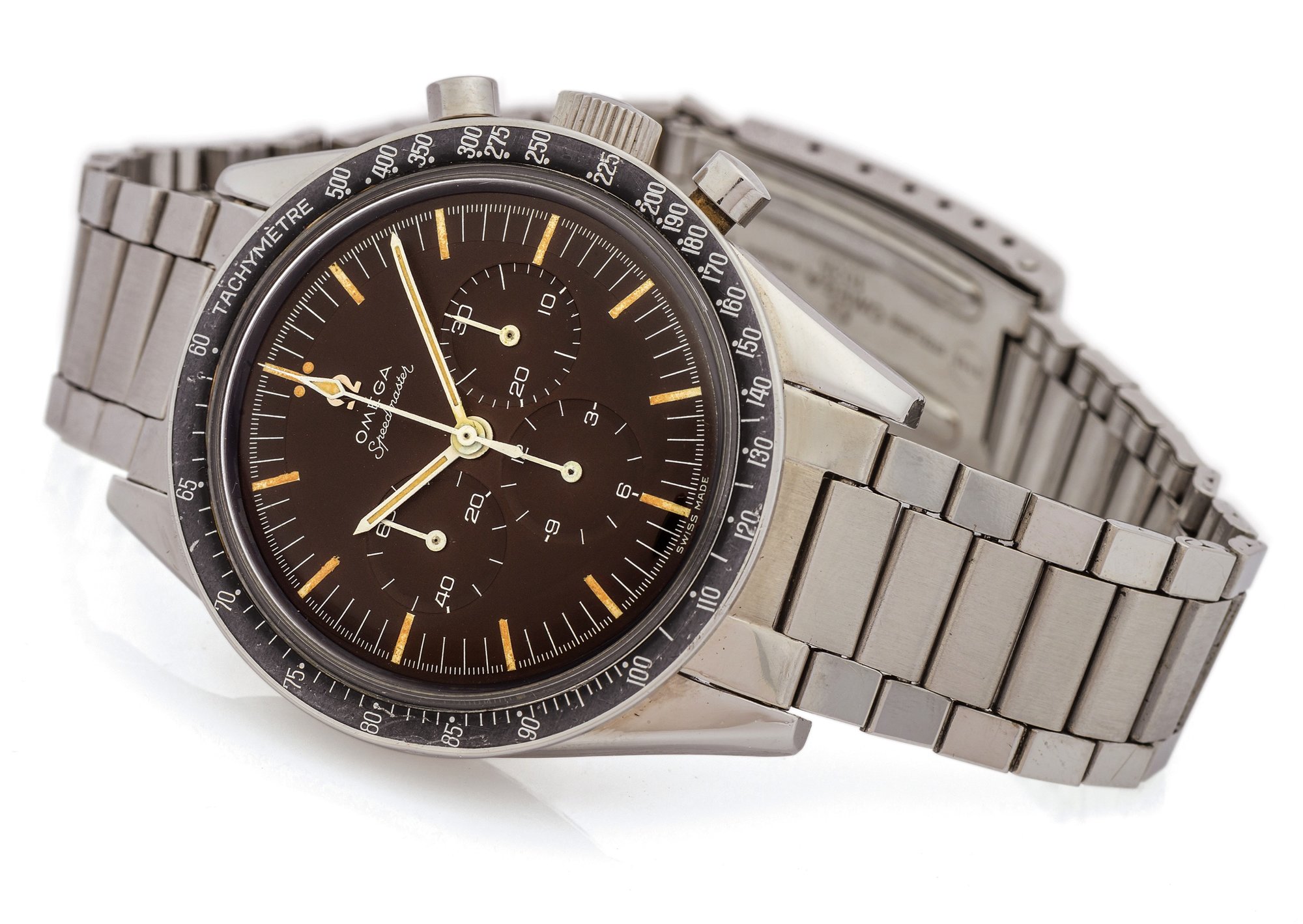
The Omega Speedmaster ST105.012
The Omega Speedmaster ref: ST105.012 is one of history’s most important and iconic watches of all time. It was the first watch to land on the moon and was worn on the wrist of Neil Armstrong and Edwin Buzz Aldrin when they first touched their feet on the moon’s surface on July 20th 1969 during the famous Apollo XI mission. The Omega Museum has revealed this information to clear up confusion surrounding the details of the first Speedmaster watch on the moon, clarifying that the model was worn by both astronauts. This, therefore, is the real Moonwatch – a fundamental link between old vintage Speedmaster watches and new ones. Launched in 1963, the Omega Speedmaster ST105.012 marked some important changes to the manufacture of the iconic watch. One of the major improvements was the design of the Speedy’s case. Its larger size of 42mm now featured added protection to its push-pieces and crown.
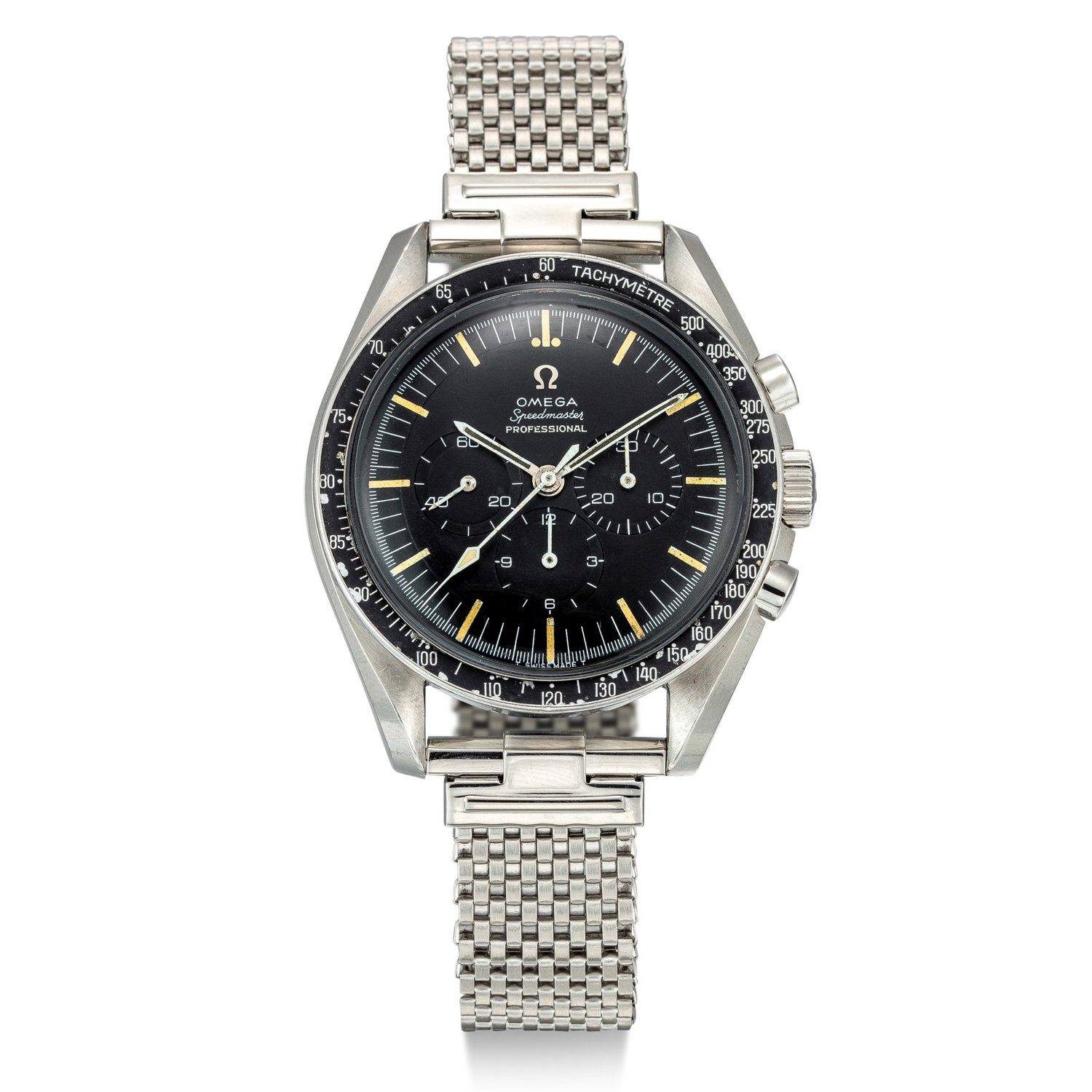
In addition to this, the lugs were no longer straight and instead boasted faceted “Lyre” lugs. A rubber membrane was also fitted inside the construction of the case to enhance water resistance. To many serious collectors, the Omega Speedmaster ref: ST105.012 is classified as the real Moonwatch and, alongside the ref: 145.012, was the last to be powered by the Calibre 321. After this, Omega went on to equip its Speedmaster watches with a cam-operated movement. One key thing to note about the design of the ref: ST105.012 is that it shares many characteristics with current Omega Speedmaster watches today.
At a glance:
Name; Omega Speedmaster ST105.012
Reference; ST105.012
Case: 42mm stainless steel / “Lyre lugs”
Bezel: Black aluminium insert tachymeter bezel
Glass: Domed hesalite
Release year: 1963
Dial: Black stepped dial/recessed sub-dials with circular guilloche finish/tritium-filled baton hands and baton indexes
Strap: Stainless steel
Movement: Calibre 321
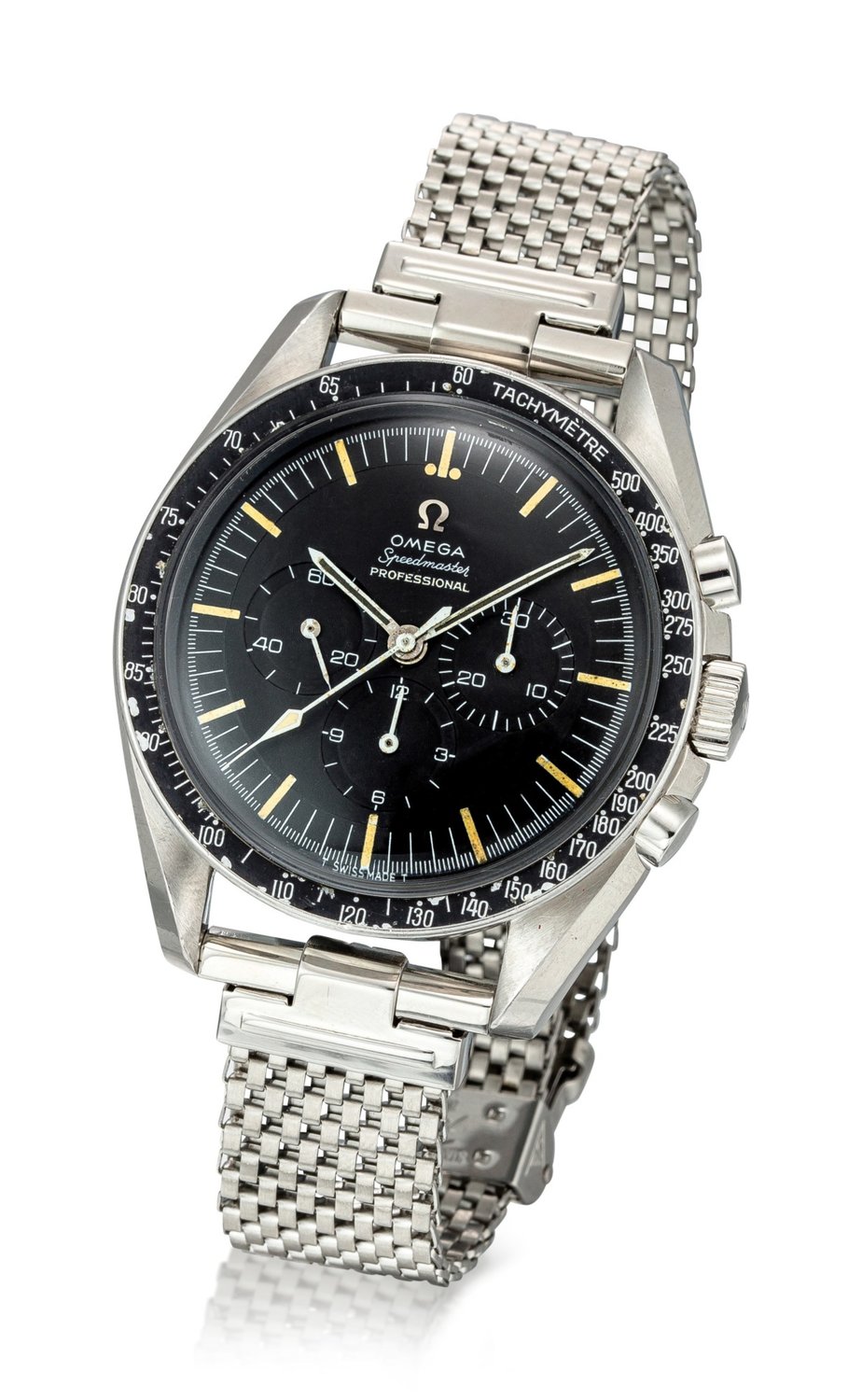
The Omega Speedmaster Moonwatch 145.012 – the Alaska Project prototype
After a few years of using the Bienne-based watchmaker’s Speedmaster watches, NASA teamed up with Omega in 1967 to improve the qualities of the iconic watch even more with the launch of the Alaska Project -a code name for a strictly secret project. Omega wanted to make the watch even more resistant to extreme temperature and so created the Speedmaster Moonwatch 145.012 as a prototype. The goal was to create the perfect Space Watch that could survive extremely hot and extremely cold environments. To do this, Omega needed to improve both the case and the movement’s resistance to these variables. Some prototypes were equipped with the 861 movement and were the first of the Speedmasters to do so.
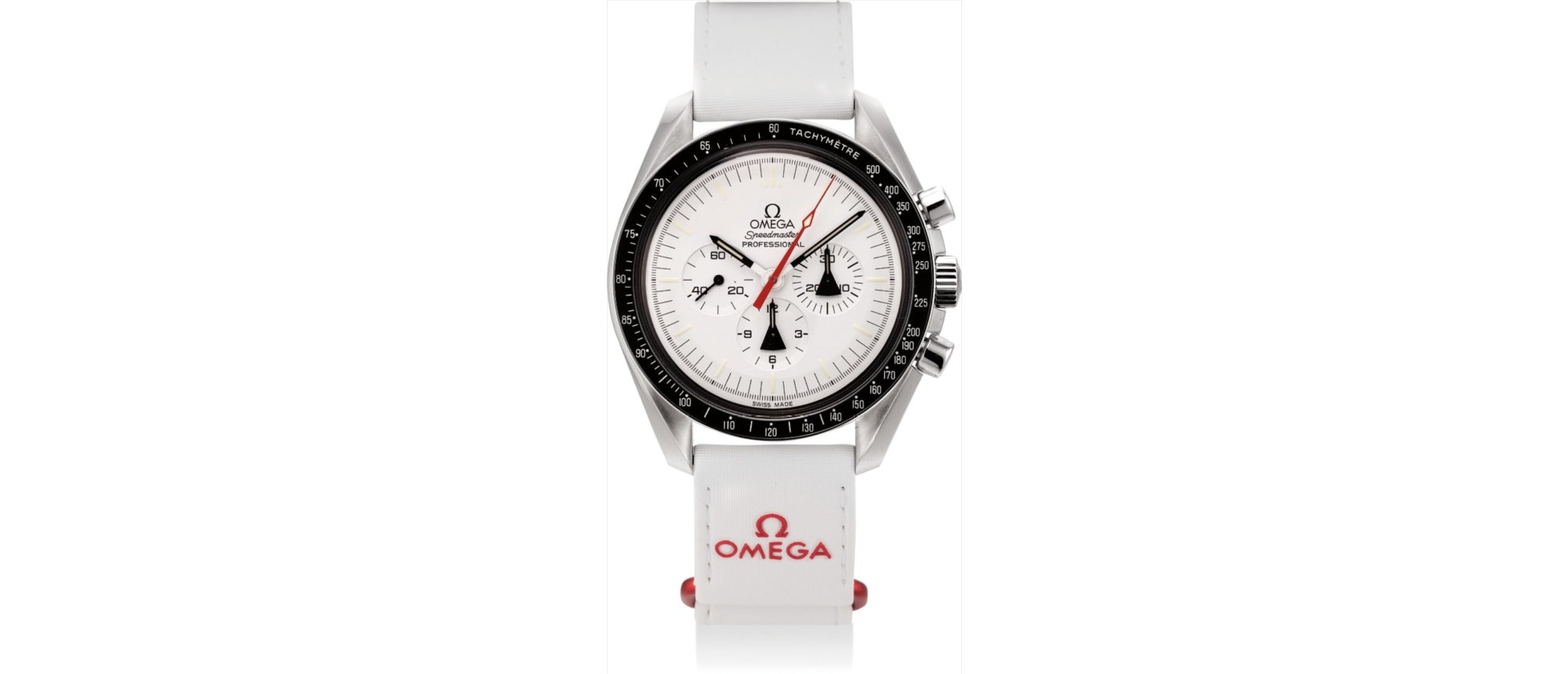
The Omega Speedmaster Moonwatch 145.012
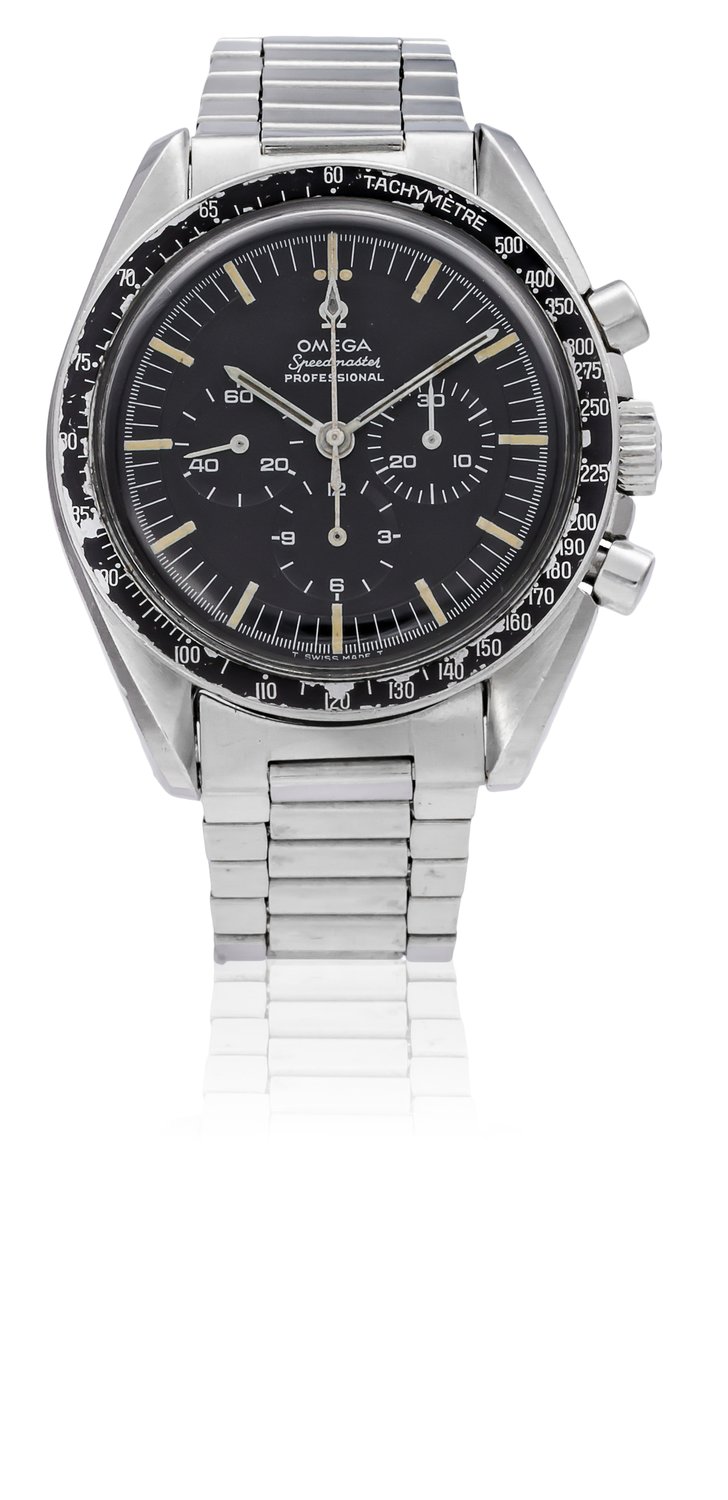
The 145.012 featured an oversized red cover crafted from anodised aluminium – a material selected for its low thermal conductivity. Its red colour is deliberately chosen for its protection against forms of radiation. Its bulkier case was also crafted from titanium – a worldwide first within the watchmaking industry. Smooth and unadorned, the case of the Speedmaster would not snag and instead brought a lightweight feel to the wrist. The dial of the Speedmaster Moonwatch ref. 145.012 had also been redesigned and now featured a different colour, an integrated scale and white hands. It was deemed successful in its mission and so the Alaska Project was deemed obsolete.
The Omega Speedmaster Mark II ref: 145.014
The Omega Speedmaster ref: 145.014 introduced the start of the Mark series and was named the Speedmaster Mark II ref: 145.014, followed by the Mark III, which used Omega’s first automatic chronograph movement. Borrowing some of the innovative features designed for the Alaska Project, the Speedmaster Mark II watch, released in 1969, was both functional and practical but was developed with a more consumer-oriented approach. It used a different case shape. Its archetypal 1970s style egg-shaped case measured 45mm x 41mm and featured integrated lugs. With no angled facets and echoing the same unadorned and smooth concept incorporated for the prototype of the Alaska Project, this vintage Speedmaster watch featured an integrated tachymeter bezel, but for legibility, the scale was printed onto the surface of the crystal’s inner face.
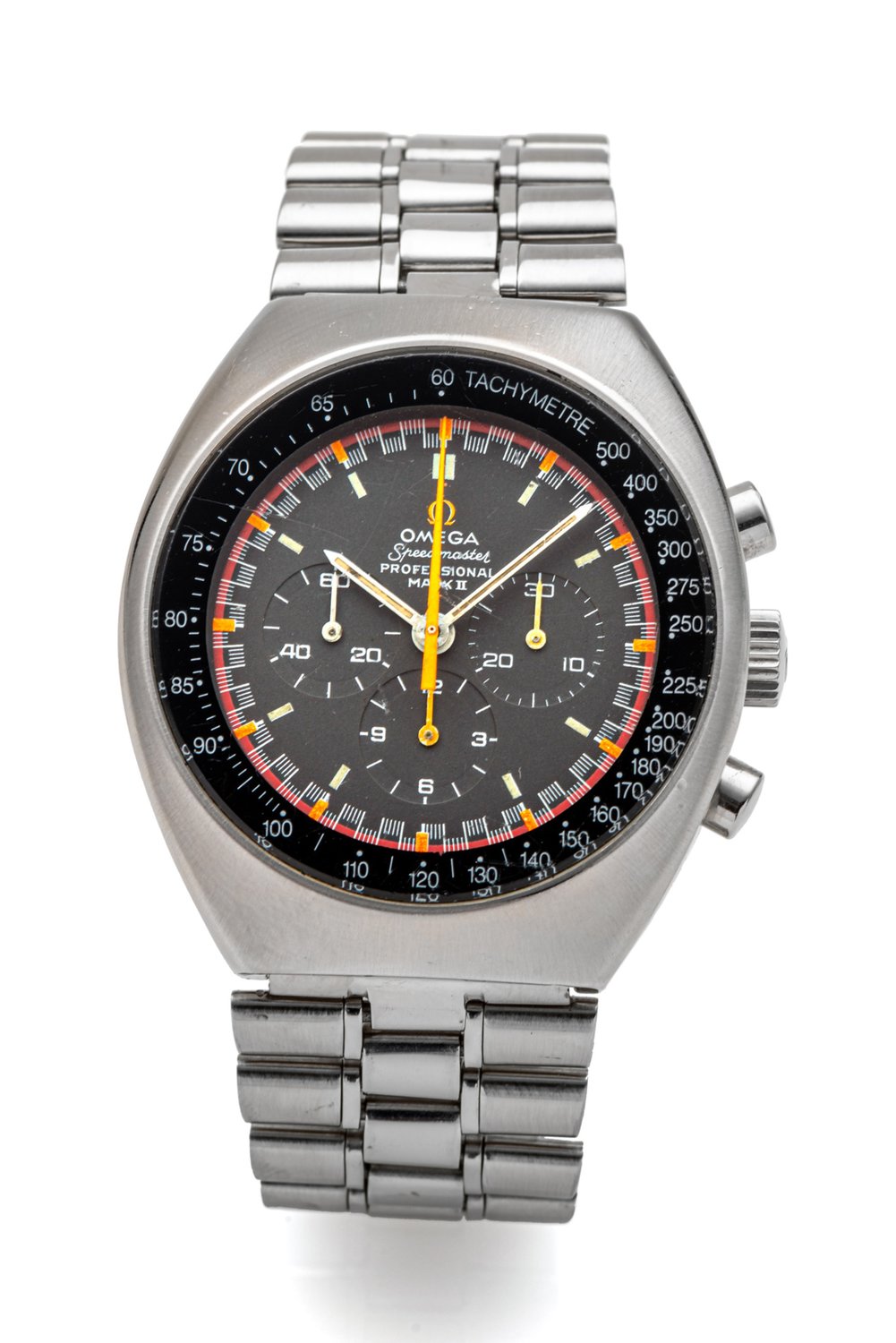
. The crystal was no longer domed hesalite either, it was now flat and crafted from mineral glass. Although similar to previous Omega Moonwatches, the Speedmaster Mark II 145.014 featured one main difference – the addition of the “Mark II” and “Professional” lettering emblazoned onto the surface of the dial under the 12 o’clock location. The dial was also made available in a dark grey racing-inspired colour with orange accented minute details and orange-coloured hands. Otherwise, the same hands and indexes were once again present in this Speedy ref: 145.014 and the watch was fitted with the Calibre 861 – a modified evolution of the Calibre 321 with cam lever operation. From a collector’s point of view, this vintage Omega Speedmaster remains one of the most affordable iterations. Omega recreated the popular watch in 2016 with a very faithful re-edition, complete with the same case and bezel design and a black or racing dial version. Alongside these, Omega also released the 2016 Rio Olympic Games Special Edition with the three counters represented in 925 sterling silver, 18ct yellow gold and bronze.
At a glance:
Name; Omega Speedmaster Mark II ref; 145.014
Reference; 145.014
Case: 45mm x 41mm egg-shaped stainless steel / integrated lugs
Bezel: Integrated tachymeter scale printed on the inner face of mineral glass
Glass: Flat mineral
Release year: 1969
Dial: Black or dark grey racing dial/tritium-filled baton hands and baton indexes
Strap: Stainless steel
Movement: Calibre 861
The Omega Speedmaster Mark III ref: 176.002
Launched in 1971, the Omega Speedmaster Mark III featured an automatic chronograph movement for the very first time. The movement was jointly designed by Omega and Lemania and also went by the name Lemania Calibre 1341. Earlier models bare the ‘Omega Automatic Speedmaster Mark III’ reference on their dials while later models feature the ‘Omega Speedmaster Professional Mark III’ lettering separately to the “Automatic” reference at 3 o’clock. The layout of this Omega Speedmaster Professional watch is different to others that have been before it.
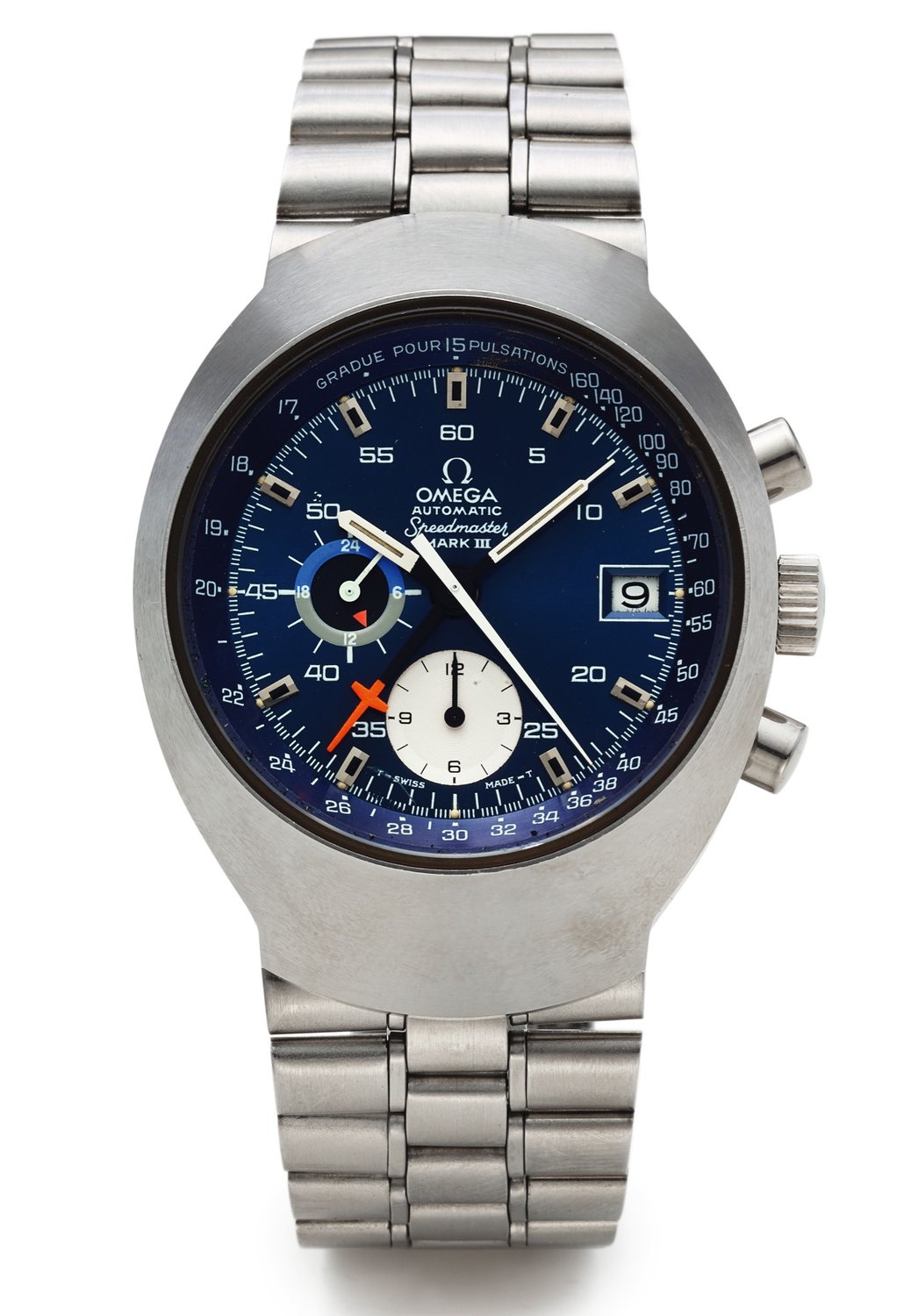
The black dial features a 12-hour totaliser at 6 o’clock and a 24-hour sub-dial at 9 o’clock. The Speedmaster Mark III was also made available in silver and blue-coloured dial versions and was produced between the years 1971 and 1973. The case of the Omega Speedmaster Mark III ref: 176.002 measures 51.6mm x 41mm and boasts a thick case depth. Symbolic of the era it was produced in, the Speedy and other luxury sports watches were sought-after for their bulky profile and unmissably bold look.
At a glance:
Name; Omega Speedmaster Mark III ref; 176.002
Reference; 176.002
Case: 51.6mm x 41mm egg-shaped stainless steel / integrated lugs
Bezel: Integrated tachymeter scale printed on inner face of mineral glass
Glass: Flat mineral
Release year: 1971
Dial: Black dial/tritium-filled baton hands and baton indexes/24-hour sub-dial at 9 o’clock
Strap: Stainless steel
Movement: Lemania calibre 1341
The Omega Speedmaster 125 ref: 378.0801
The Omega Speedmaster 125 is a very special watch, which launched in 1973 to mark the famous watchmaker’s 125th anniversary. The automatic chronograph, although always having been powered by a reliable movement, now featured an automatic chronograph movement with a specially certified rating. After the production of the Omega Speedmaster Mark III ref: 176.002, a batch of 2000 Lemania 1341 Calibre based movements (originally used to power the Mark III model) were produced and certified by the Swiss Institute for Official Chronometer Tests.
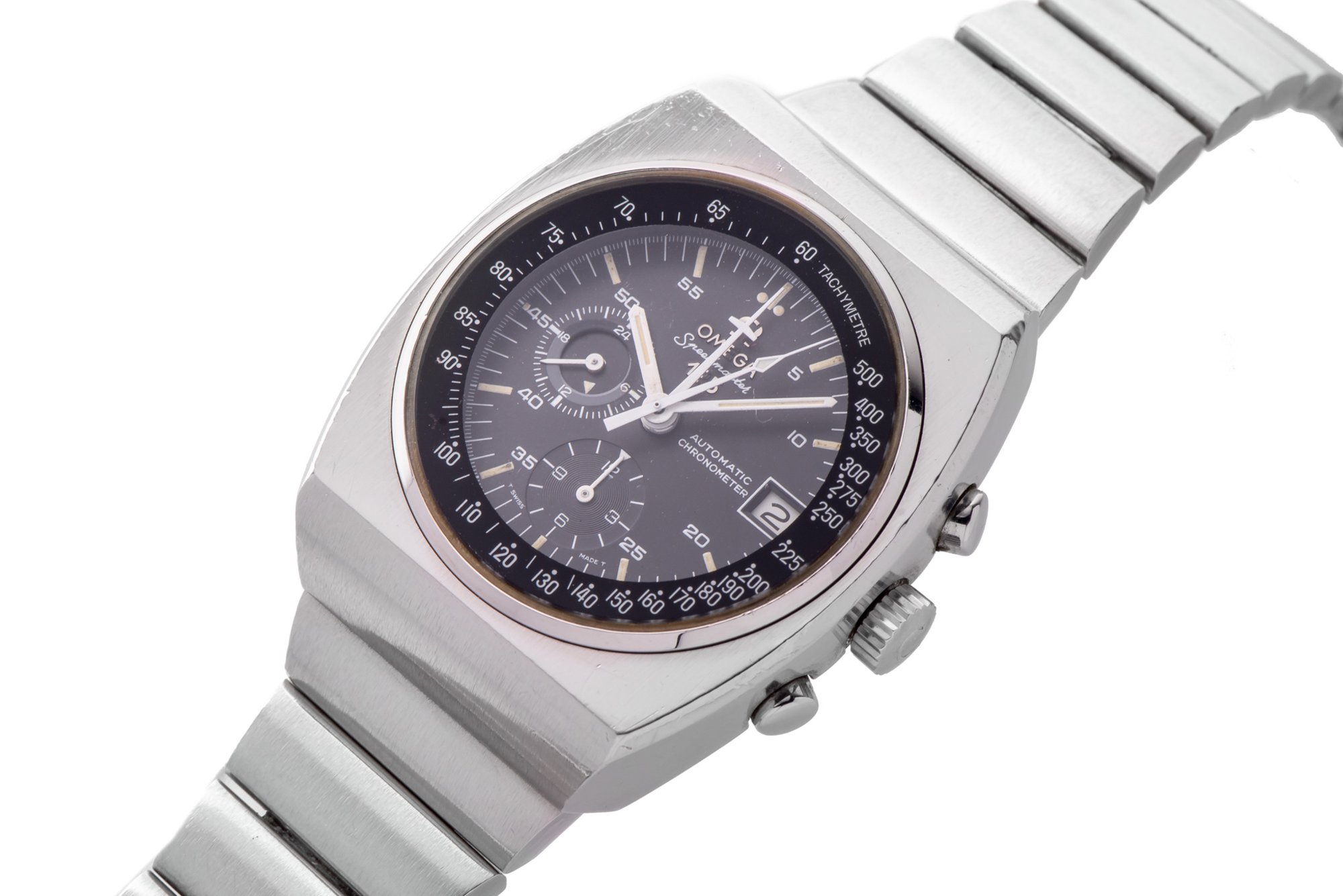
As such they were given a chronometer-certified rating, deeming them official chronometers with uncompromising timekeeping efficiency. To mark its 125th anniversary, Omega released a limited-edition Omega Speedmaster 125 ref: 378.0801 watch. Exclusive to just 2000 pieces worldwide, these limited edition Speedy watches were equipped with this special version of the Lemania Calibre 1341 – the chronometer-certified Calibre 1041. This was Omega’s very first chronometer-rated chronograph watch and its first chronometer-rated automatic chronograph movement. This special engine also housed a new main plate and rotor as well as a new chronograph bridge, promising better overall mechanical performance. Because it featured a special variant of Omega’s first automatic chronograph movement, the Speedmaster 125 ref: 378.0801 remains a popular collectable to add to any growing Speedmaster watch collection. The case of the Speedmaster 125 ref: 378.0801 is also constructed in a different way to previous models in that it is assembled by two separate parts. The inner case encloses the dial, bezel and movement, which then fits into a chunkier case featuring the O-ring gasket for the crown. This interchangeable module for the movement and dial shares the same construction with the Mark IV models which followed, albeit in a tonneau-shaped case. Sitting at a 15mm height on the wrist, the Omega Speedmaster 125 watch is considerably hefty and bold. Its case dimensions measure: 51mm x 42mm and the model comes with an integrated stainless steel bracelet. Differing from other Speedy watches produced at that time, the 125 limited edition watch features an applied Omega logo as opposed to a painted one. Constituting a real collector’s piece, the Speedmaster 125 is surprisingly easy to find on the pre-owned market, however many models that appear to be the “real deal” can sometimes be modified due to the interchangeable module, often meaning that the watch has been reassembled and swapped with the very similar Calibre 1040, replacing the much rarer Calibre 1041. Those seeking the Omega Speedmaster 125 ref: 378.0801 on the second-hand market should clearly and closely inspect the engraved chronograph bridge of the watch before parting with their money.
At a glance:
Name; Omega Speedmaster Limited Edition 125 ref: 178.0801
Reference; 178.0801
Case: 51mm x 42mm - interchangeable module – 2-piece case construction – stainless steel
Bezel: Integrated tachymeter scale printed on inner face of mineral glass
Glass: Flat mineral
Release year: 1973
Dial: Black dial/tritium-filled baton hands and baton indexes/24-hour dial at 9 o’clock/date at 3 o’clock
Strap: Stainless steel
Movement: COSC-certified Calibre 1041
The Omega Speedmaster 1045 TV Dial ref. 176.0014
The fashion-influenced 1970s TV Dial Speedy boasts a strikingly unusual case shape along with a distinctive colour. The watch is powered by the Lemania 5100 movement, also known as the Omega 1045 automatic chronograph movement and features central hour and minute hands, a 24-hour sub-counter at 6 o’clock, a small second sub-dial at 9 o’clock and a 24-hour counter at 12 o’clock. These sub-dials are balanced by a day-date feature located against a legible white background at 3 o’clock – all framed by an instantly recognisable TV shaped case and bezel. The black tachymeter scale is once again located around the periphery of the dial.
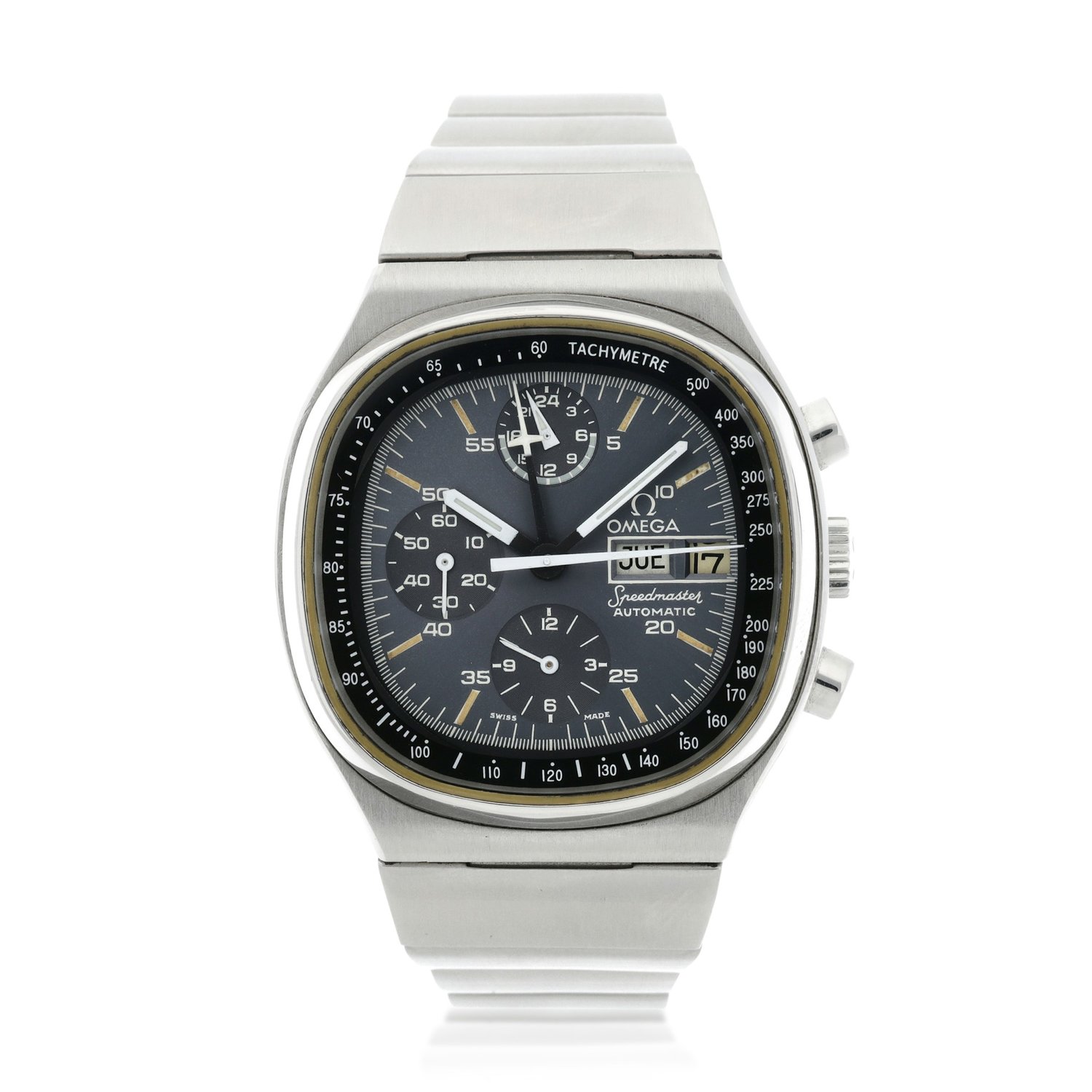
Vintage watch collectors have long sought out the iconic 1970’s TV Dial Speedmaster watch ref: 176.0014 due to its remarkable shape and the efficiency of its chronograph complication. The rounded edges of the square-shaped case impart a retro edge to the design, making it just as fashionable on the wrist today as it was over half a century ago. This Speedmaster watch also boasts a deep sunburst blue dial colour as opposed to the standard black dial versions of the company’s ever-growing catalogue. Interestingly, Omega chose to keep the same style of stainless steel bracelet that was sported on the Speedmaster 125 watch – the integrated bar bracelet. Echoing the direction that the Speedy watch was going in during this era, the case of the Omega Speedmaster 1045 TV Dial watch is large and bulky but still considered more wearable than the limited edition 125 Speedmaster.
. Similar to the Mark Editions, although not easy to find, the TV Dial 1045 ref: 176.0014 Speedmaster is highly desirable and surprisingly undervalued, making it a great investment for first-time vintage Omega watch collectors. Considered one of the more eccentric Speedmasters, this iteration certainly breaks Speedmaster norms and imparts an instantly noticeable look upon the wrist. The watch began production in 1974 and lasted three years, ceasing production in the year 1977 and remains one of the furthest removed designs from the classic Speedmaster design, purely for its unique design elements. As well as the deep blue sunburst dial variation, the TW Dial Speedmaster was also released in its classic black dial version. Currently, you can expect to pay around 4k upwards for one of these models – its price tag owing to its rare stye credentials and memorable aesthetics.
At a glance:
Name; Omega Speedmaster 1045 TV Dial ref: 176.0014
Reference; 176.0014
Case: 42mm x 43mm – square-shaped case with rounded edges – stainless steel
Bezel: Integrated tachymeter scale printed on inner face of mineral glass
Glass: Flat mineral
Release year: 1974
Dial: Dark blue sunburst or black dial/tritium-filled baton hands and baton indexes/24-hour dial at 12 o’clock/day-date at 3 o’clock
Strap: Integrated stainless steel bracelet
Movement: Lemania 5100
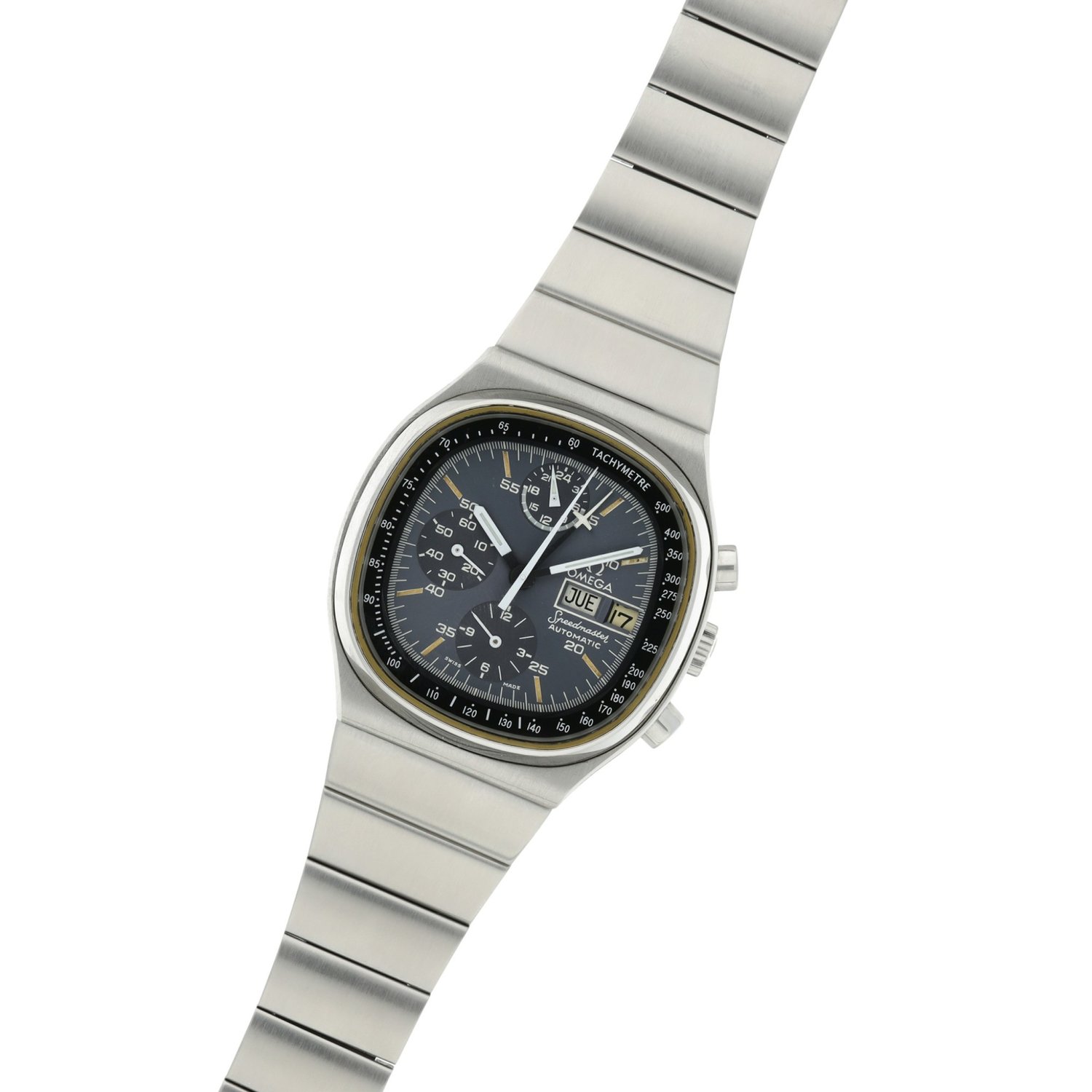
Limited Editions
In this ultimate guide to understanding the Omega Speedmaster, we’ve highlighted some of the most iconic models that have shaped the history of one of the world’s most famous watch collections. We have looked at the early Moonwatch models as well as some rare 1970s editions, including those shaped by Omega and NASA’s Alaska Project. Before closing the article, here are some rare and limited edition vintage Speedmaster watches that have become remarkably collectable on the pre-owned market.
The Omega Speedmaster Apollo XI ref; BA 145.022
The Apollo XI series pays tribute to the Speedmaster’s largest achievement, thus becoming known as the Moonwatch and signifying the date at which the Eagle landed on the moon on July 20th 1969. The Speedmaster Apollo XI ref: 145.022 was clothed in a luxurious 18ct yellow gold case with a matching gold coloured dial, surrounded by a rich burgundy bezel. The watch is also engraved with the “First Watch on the Moon” lettering and the “Apollo XI” reference on the back of the case. Out of the 1014 pieces produced, 38 were offered to astronauts as well as President Nixon and Vice President Agnew. This full yellow gold edition is a highly sought-after model on the pre-owned market since the Speedmaster Is predominantly a stainless steel watch. The hour markers on the dial of the Speedmaster Apollo XI ref; BA 145.022 are rectangular shaped and the watch is powered by the Calibre 861. Other subtle differences, which set the all-gold Speedmaster apart from the classic stainless steel Speedmaster Professional watch ref: ST 145.022 include the aforementioned applied indexes in black, framed by polished gold rims and the black non-luminous central hour and minute hands. The Omega Speedmaster Apollo XI ref: BA 145.022 is a rare edition that barely ever comes up on the pre-owned market, but should it do, you can expect to pay a price in excess of 15-20K Euros.
Name; Omega Speedmaster Apollo XI ref: BA 145.022
Reference; BA 145.022
Case: 18ct yellow gold case
Bezel: Burgundy tachymeter bezel
Glass: Domed hesalite
Release year: 1969
Dial: Gold dial with black rectangular-shaped baton indexes and black non-luminous central hands
Strap: Integrated 18ct yellow gold bracelet
Movement: Calibre 861
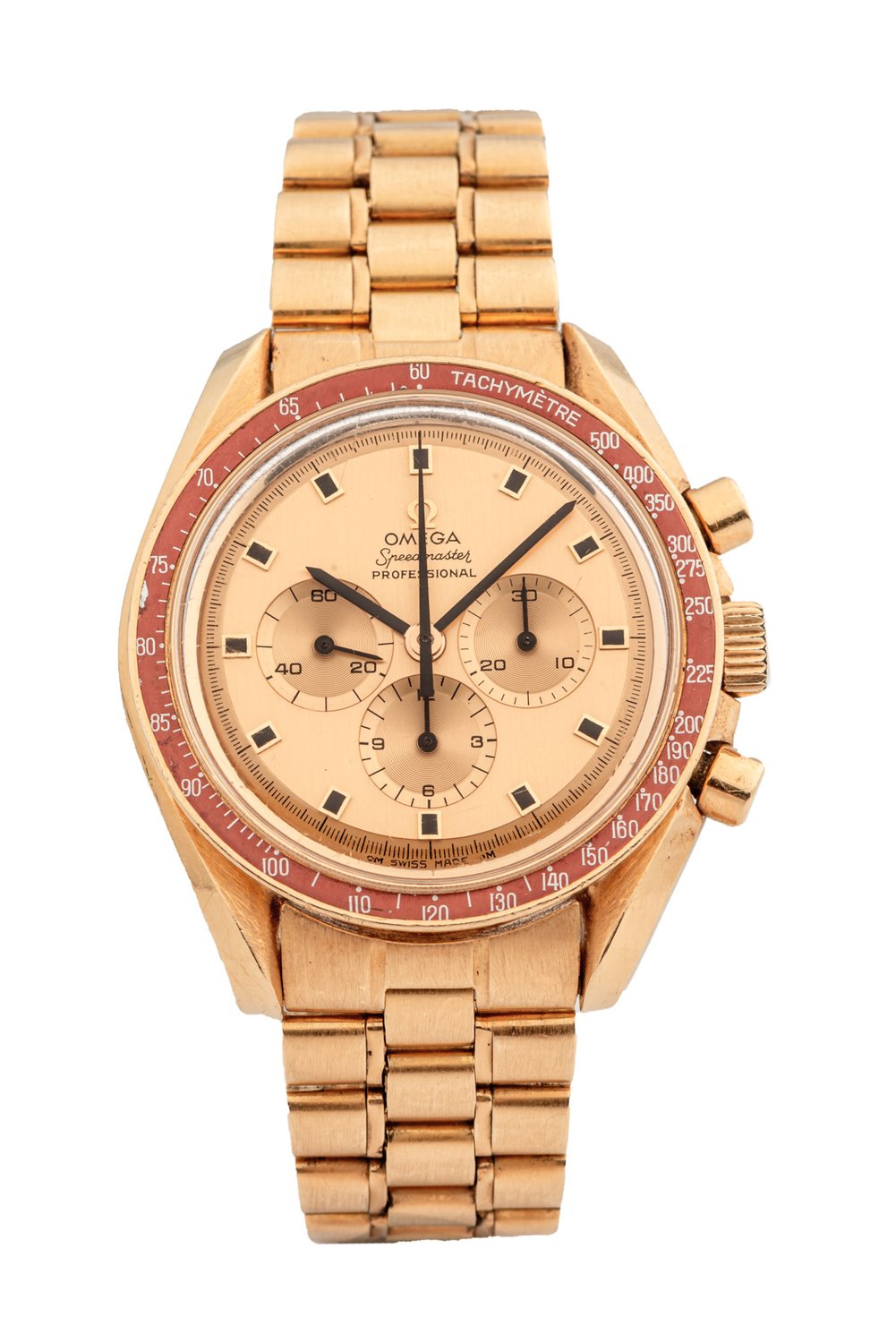
Speedmaster Apollo XI 1980 ref. BA 345.0802
In 1980, Omega produced its very first Speedmaster watch which a transparent caseback. The ref: BA 345.0802 was a model that featured an all-gold case crafted from 18ct yellow gold and a black bezel, echoing the design of the classical Moonwatch. This is now a classic collector iconic gold watch. The transparent caseback feature on the rear of the case displayed the Calibre 863 – a decorated version of the Calibre 861, putting all its intricate finishes and its complex arrangement on view. Engraved onto the caseback around the glass viewing window is the “First Watch Worn on the Moon” reference along with the limited-edition number belonging to its exclusive series of 300 produced. Half of the limited-edition series was sent out to the German market and it is thought that only a dozen or fewer were fitted with a leather strap configuration. A white gold variation was also produced during 1980 and 1981, all of which are believed to have been fitted with matching white gold bracelets. The latter was the first-ever white gold Speedmaster to be produced. The yellow gold and white gold variations of the Speedmaster Apollo XI 1980 watch were the only Moonwatches to ever feature a snap-on caseback as opposed to a screwed-in caseback.
At a glance;
Name; Omega Speedmaster Apollo XI 1980 ref: BA 345.0802
Reference; BA 345.0802//BC 345.0802 (white gold)
Case: 18ct yellow gold case / 18CT white gold case - transparent caseback
Bezel: Black tachymeter bezel
Glass: Flat mineral
Release year: 1980/1981 respectively
Dial: Gold/silver dial with black baton indexes and black non-luminous central hands
Strap: Integrated 18ct yellow gold/white gold bracelet
Movement: Calibre 863
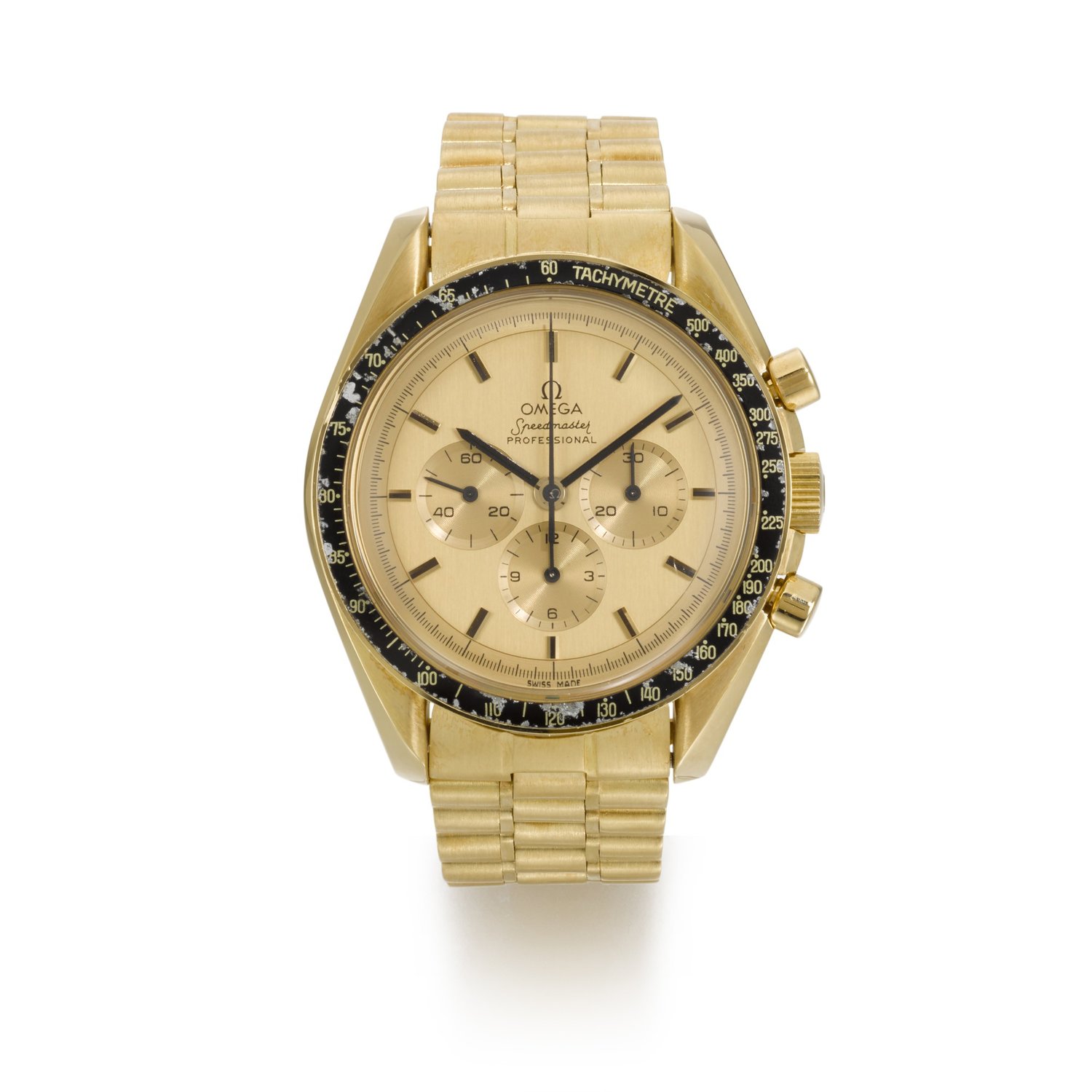
Speedmaster Apollo XI 20th Anniversary ref: ST 345.0022
The Speedmaster Apollo XV 20th anniversary was the first Speedy to celebrate an anniversary and so deserves a place within this guide to some of the most important Speedmaster references. Produced at 2000 pieces worldwide in 1989, this vintage Speedmaster watch is engraved with the serial number on the caseback and also features the “Apollo XI 1969” stamp. This Speedmaster Apollo XI 20th Anniversary watch was produced in a series of 2000 for the US market and 4000 for the rest of the world. The black tachymetric bezel graduated to 500 units per hour surrounds the classic tri-counter dial layout with 30-minute, 12-hour and small second counters arranged in the 3, 6 and 9 o’clock locations.
At a glance:
Name; Omega Speedmaster Apollo XI 20th Anniversary ST 345.0022
Reference; ST 345.0022
Case: Stainless steel
Bezel: Black tachymeter bezel
Glass: Flat mineral
Release year: 1989
Dial: Black tri-counter dial with luminous baton indexes and hands
Strap: Integrated stainless steel bracelet
Movement: Calibre 861
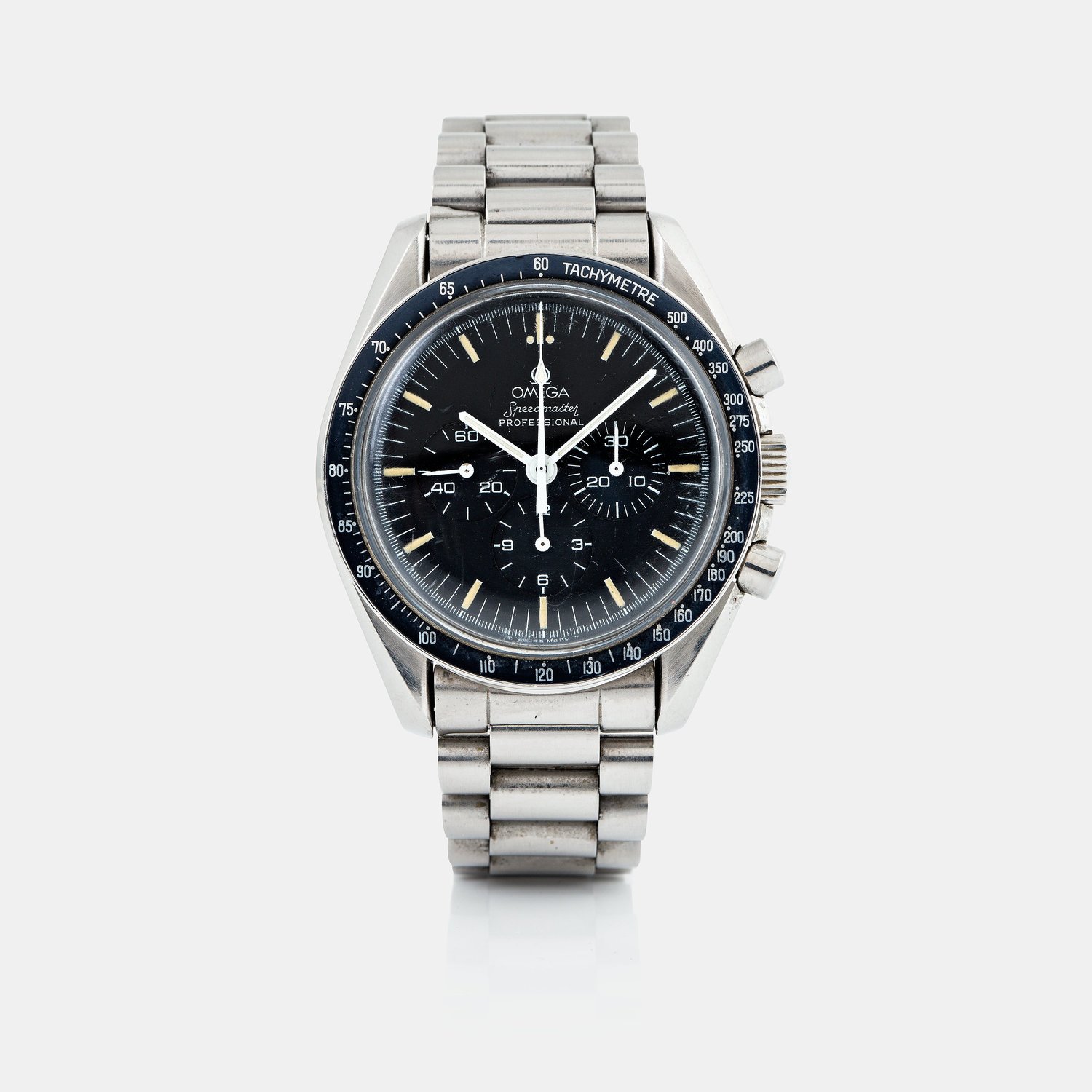
Speedmaster Apollo XI 25th Anniversary: Ref. ST 345.0062
There were four iterations of the Speedmaster Apollo XI 25th Anniversary released in 1994; one in steel with a black dial that was produced in a limited series of 2500 pieces. One chronometer-rated white gold model with a silver dial produced in a series of 500 pieces. One in platinum with a skeletonized dial produced in a limited series of 50 pieces, and one in platinum with a skeletonized dial and diamonds, limited to just 5 pieces. The white gold variations of the Speedmaster Apollo XI 25th Anniversary watch are particularly rare and desirable. The caseback is in sapphire and the left side around the glass is engraved with the “Apollo XI 1969-1994” lettering. Although the most recent of Speedmasters to feature in this article, the Speedmaster Apollo XI 25th Anniversary ref: 345.0062 is still considered a highly desirable vintage Speedmaster that marks an important point in the Bienne-based watchmaker’s heritage. The limited-to-500-pieces white gold iteration features a stunning silver-coloured dial in a sunray pattern. Unique to this addition only is the rare hands, which are crafted from polished silver metal to match with the applied hour indexes. Through the back of the case, a clear view of the Calibre 864 is granted through sapphire crystal. This is another evolution of the original Calibre 861 and comes executed in polished bevelled angles on the bridges as well as Geneva stripes.
At a glance:
Name; Omega Speedmaster Apollo XI 25th Anniversary ST 345.0062
Reference; ST 345.0062
Case: White gold (also available in Stainless steel, platinum and platinum with diamonds) – sapphire crystal glass caseback
Bezel: Black tachymeter bezel
Glass: Sapphire crystal
Release year: 1994
Dial: Silver tri-counter dial with luminous baton indexes and hands
Strap: Integrated 18ct white gold bracelet
Movement: Calibre 864
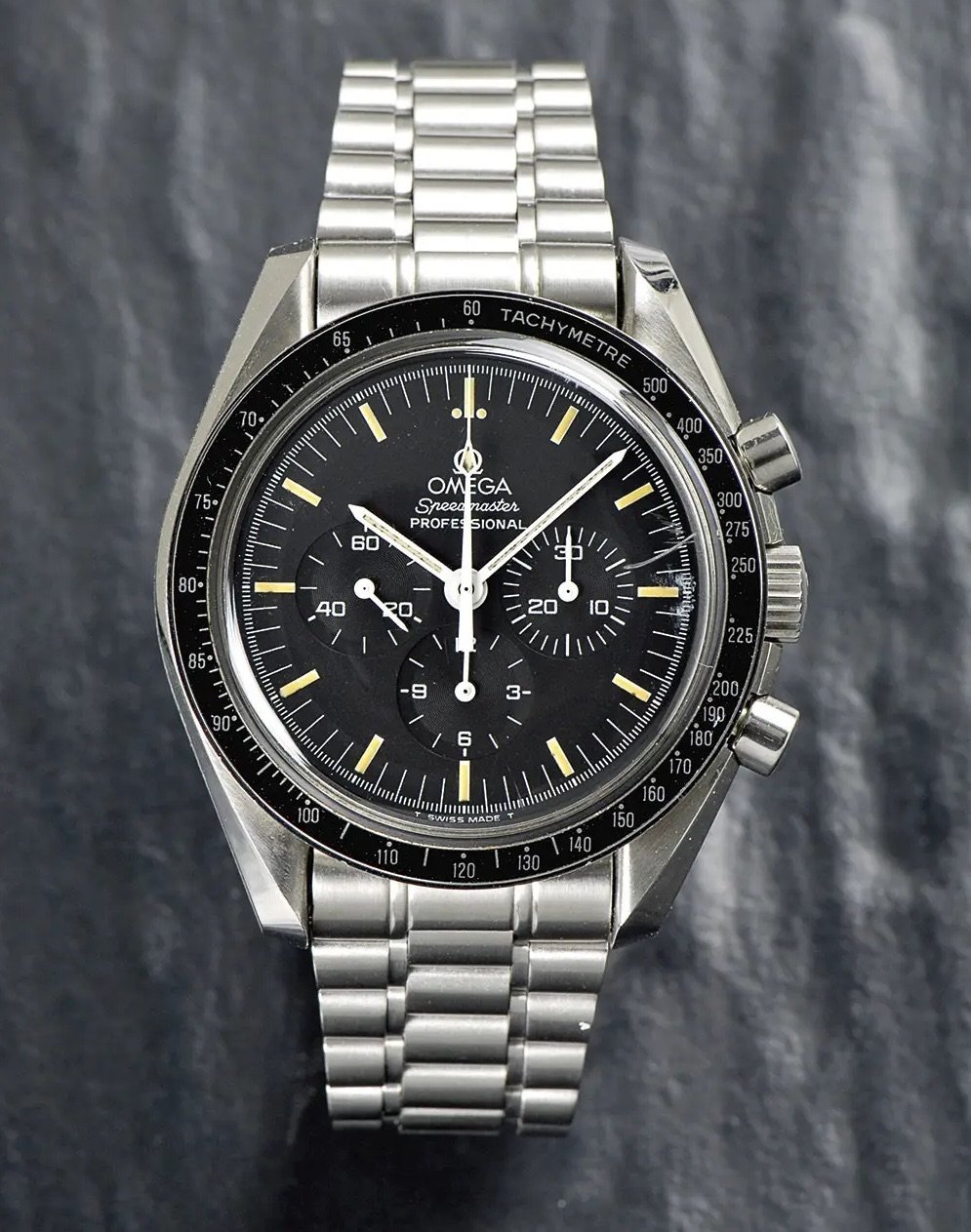
Speedmaster: Legacy and Heritage
From different dial colours, lug styles, stepped dials and a range of case materials and sizes – the Omega Speedmaster will always remain one of the most diverse and complex watch collections known to man. Whereas some collectors are new to the Speedmaster story, others have followed its journey closely from the 1950s right through to owning modern-day iterations from the brand’s current catalogue. Reflecting the collection’s vast range of designs is the price of a Speedmaster watch which spans from the more affordable models to the premium price range. Today, the Speedmaster is so much more than the so-called Moonwatch (just take a look at the Speemaster Snoopy Collection) and since the brand continues to release special editions and limited editions – each new model continues to reach a huge global following. What is consistent throughout Omega’s huge catalogue of Speedmaster Professional watches, whether vintage, pre-owned or new, is the quality of the Omega’s choice in materials and the reliability of its cutting-edge timekeeping technology, enabling young and devoted enthusiasts the chance the own their own Speedmaster watch.
